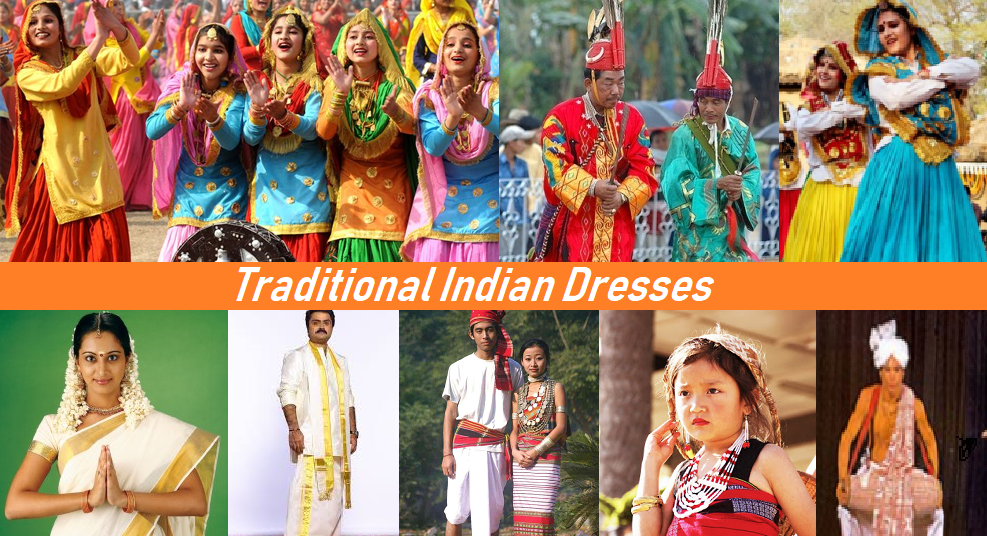
Are you interested in the traditional dress of different states of India?
India has a huge expanse that is adorned with a variety of styles, cultures and customs, languages and most importantly, customary dress. From the stunning Pheran in Kashmir in the tranquil North to the elegant Kasavu Mundu from Kerala in the lively South The country is home to an abundance of traditional clothing.
These outfits are not just an issue of fashion or fashions; they are the main themes of India’s rich culture story. People of different religions as well as dialects, cultures, regions, race and ethnicity are able to live together. Because of this uniqueness between people the traditional dresses of different states of India have certain characteristics that are unique to them.
For this piece, we’ll explore the traditional dresses and costumes from all the traditional-dresses-Indian-states, examining their cultural significance, variety and beauty.
Understand the Traditional Dresses of Different States of India
India has the appearance of a chameleon. It changes its textures and colours as you move across the landscapes. Each state, every city, every corner and nook has a distinct identity, rooted in history and traditions. Traditional attire is among the more vibrant manifestations of this culture variety.
What are the Importance and Symbolism of Traditional Dresses
Like regional languages that convey the cultural pulse of a particular region Traditional dresses express its values. They convey the essence of the folklore of a region’s art and history, while subtly weaving the stories of past time periods into the present day weaving a beautiful blend of heritage, culture and heritage.
Overview of Rich Heritage of Clothing in India
The rich Indian clothing collection has evolved, changed and been in the process of being influenced by its historical periods, foreign incursions, and social changes. Every time, Indian attire has readily been adorned in the hues of changing times, forming an ongoing record of India’s social, historical and cultural context.
North Indian States: Cloaked in Tradition
When it comes to the old-fashioned way of dressing Northern states of India have it covered with aplomb and grace. The fads of Pheran Salwar Kameez, Pheran Lehenga Choli are a testament to the diversity of the culture of the region.
1. Kashmir: The Resplendent Pheran
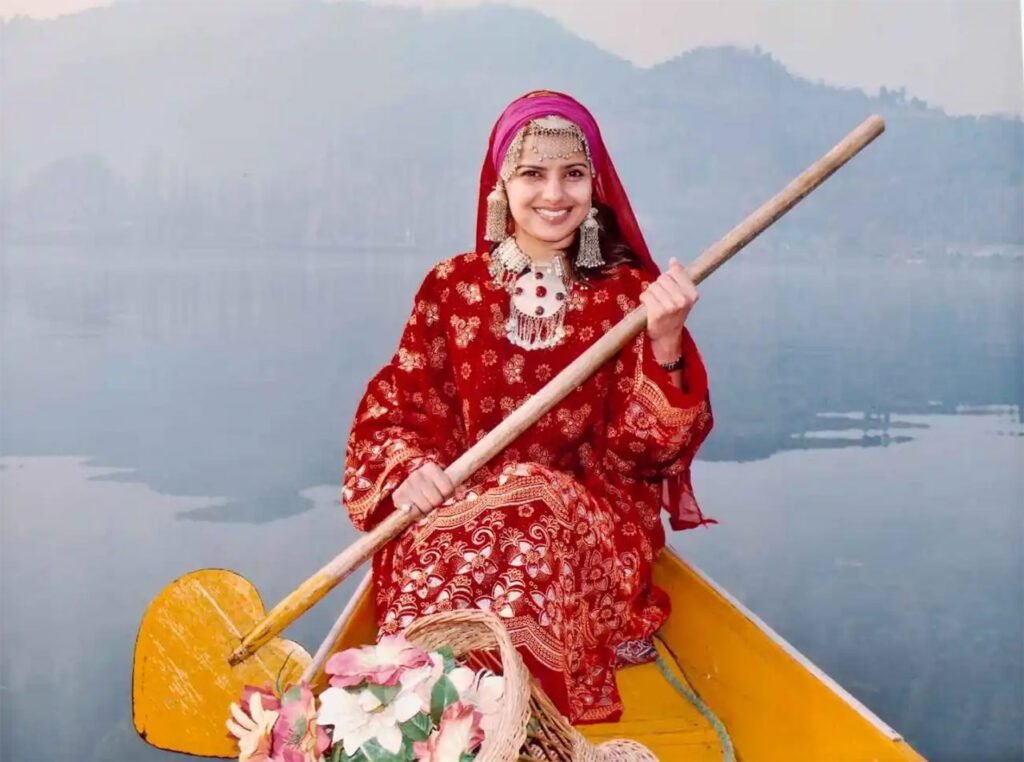

A Pheran is more than just a piece of clothing; it’s part of the spirit that is Jammu as well Kashmir. Through the years this costume has become the symbol of Kashmiriyat, the cultural, ethnic, and social harmony that is Kashmir.
Brief History of Pheran
Pheran the epitome of elegance and simplicity is a symbol of the strength that is the Kashmiri spirit in the face of the brutal Himalayan winters. The roots of Pheran’s modest beginnings can be traced to the time of Sultan Zain-ul-Abidin who introduced the use of it to guard against cold weather.
Significance and Fashion Evolution of Pheran
Pheran has the impressions of the hills, valleys and the changing colors that are characteristic of Kashmiri seasons. The first version was a simple design composed of coarse fabric it has transformed into an elegant fashion statement, featuring intricate embroidery and luxurious shahtoosh or pashmina fabric.
Occasions where Pheran is traditionally worn
Pheran is both day-to-day outfit as well as an outfit for special occasions thanks to its flexibility. When it comes to festivals, specifically “Eid” as well as “Navroz”, Pheran takes the center stage in the rousing tunes of the old Kashmir.
2. Punjab: The Vibrant Salwar Kameez
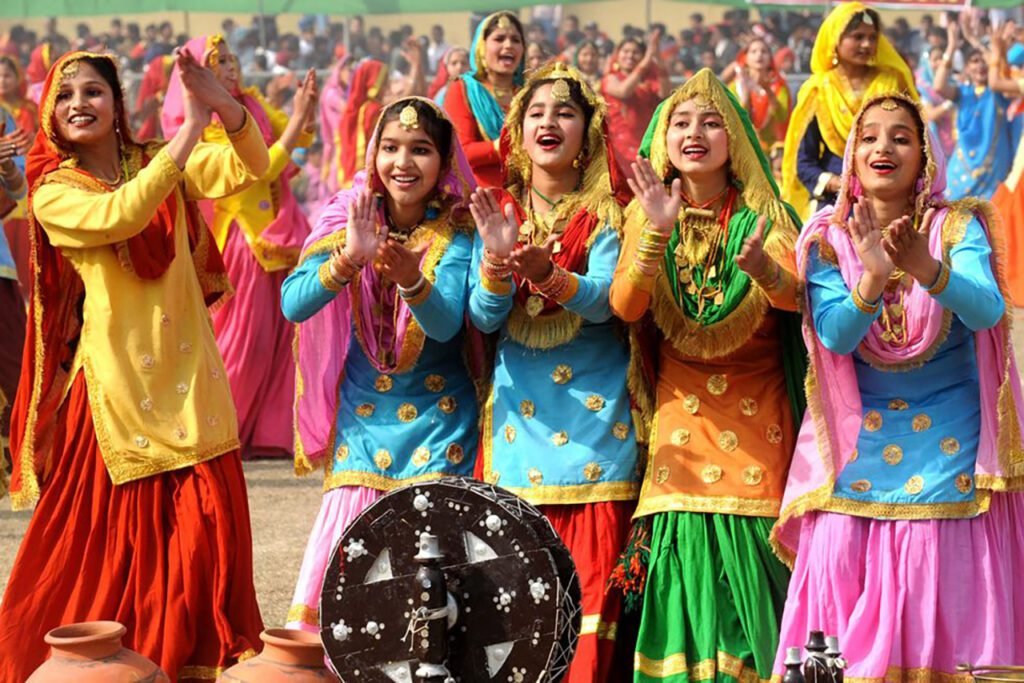

A visit to India’s fashion palette would be incomplete without a visit to Punjab’s lively Salwar Kameez. Always trendy the outfit is a clear and loud representation to the Punjabi spirit – vibrant lively, energetic and vibrant.
Origin and Evolution of Salwar Kameez
Salwar Kameez, which was a donation from Mughals initially served as an appropriate attire for ladies. It is now a way to transcend the gender divide and has a place of honor in the current fashions. Its transformation from a basic, loose-fitting piece of clothing to elegant, streamlined clothing is a testimony to its continuous development.
Significance and Variations of Salwar Kameez
Salwar Kameez brings to life the vibrant Punjabi culture. From Patiala salwars to dhoti salwars to churidar suit every variation is an original mix of modernity and tradition and dances on the stage of the fusion.
Salwar Kameez – An Integral Part of Punjabi Festivals and Functions
Weddings or birthdays informal or auspicious Salwar Kameez is one of the most general Punjabi dress code that demonstrates its presence in all places. The vibrancy of the dress is prominent especially during “Baisakhi” which is a resounding reminder of the vibrant spirit of harvest festival.
3. Rajasthan: The Colourful Lehenga Choli
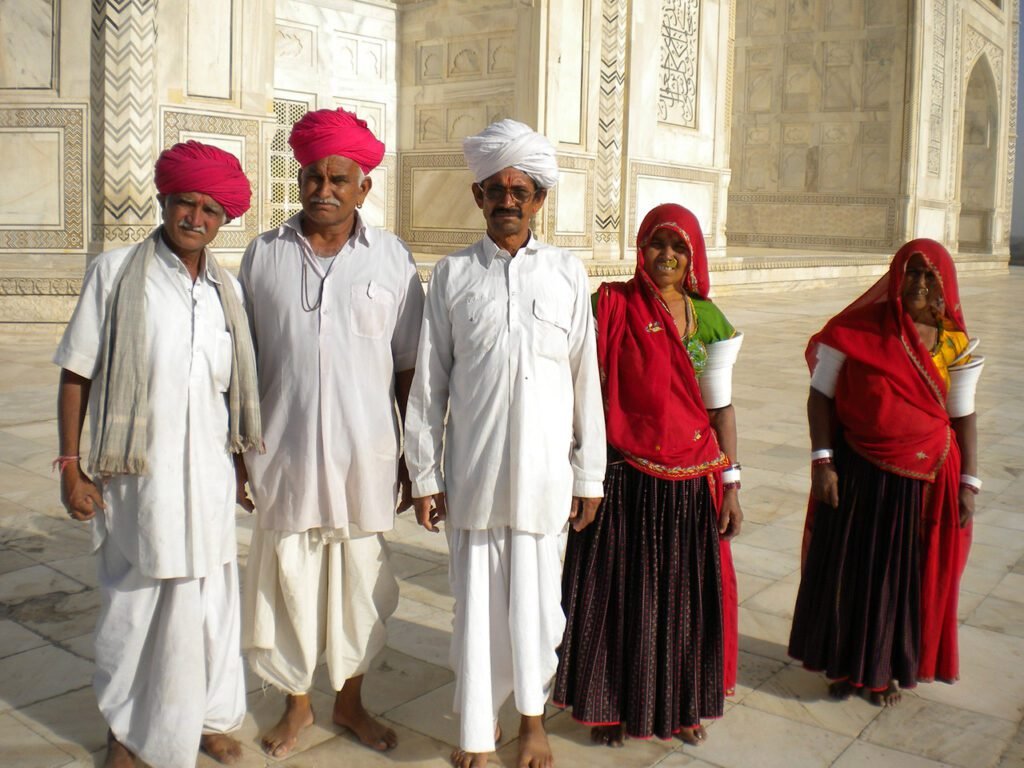

In the sand dunes, and the grand Rajputana forts, it is possible to find the Rajasthani woman in all her pure beauty with her lehenga choli traditional. It’s like a poem in motion, an evocative representation of the state’s rich heritage.
Legacy and Varieties of Lehenga Choli
Traditional Rajasthani Lehenga Choli is believed to be from the Mughal time period an era of fashion that has been through the ages. There’s a wide range of styles that ranges from the plain cotton ghagras worn by women in rural areas to the extravagant silk ones decorated with ‘gota-patti “zari” or “kundan works for celebrations.
Significance and Cultural Importance of Lehenga Choli
It’s more than a gown, Lehenga Choli is a canvas that represents Rajasthan’s heritage and culture, as well as its royal splendor. It’s more than an expression of style it is a symbol that reflects the hand-woven art-based practices of Rajasthan.
How Lehenga Choli Embodies the Spirit of Rajasthan
The lively and varied Lehenga Choli conveys the essence of Rajasthan – from the valour of its rulers to the stories of the hard-working people. Every festival or fair including the ‘Teej’ and the “Gangaur,” Lehenga Choli dances and swirls, telling the stories of Rajasthan.
East Indian States: A Tapestry of Collaborated Traditions
The states of East India are the gateways to the world of traditional and traditions that have been expertly joined. It is evident that the Bengali Saree as well as the Assamese Mekhela Chador evoke the spirit of East India.
1. West Bengal: The Elegant Saree Conveying Grace and Simplicity
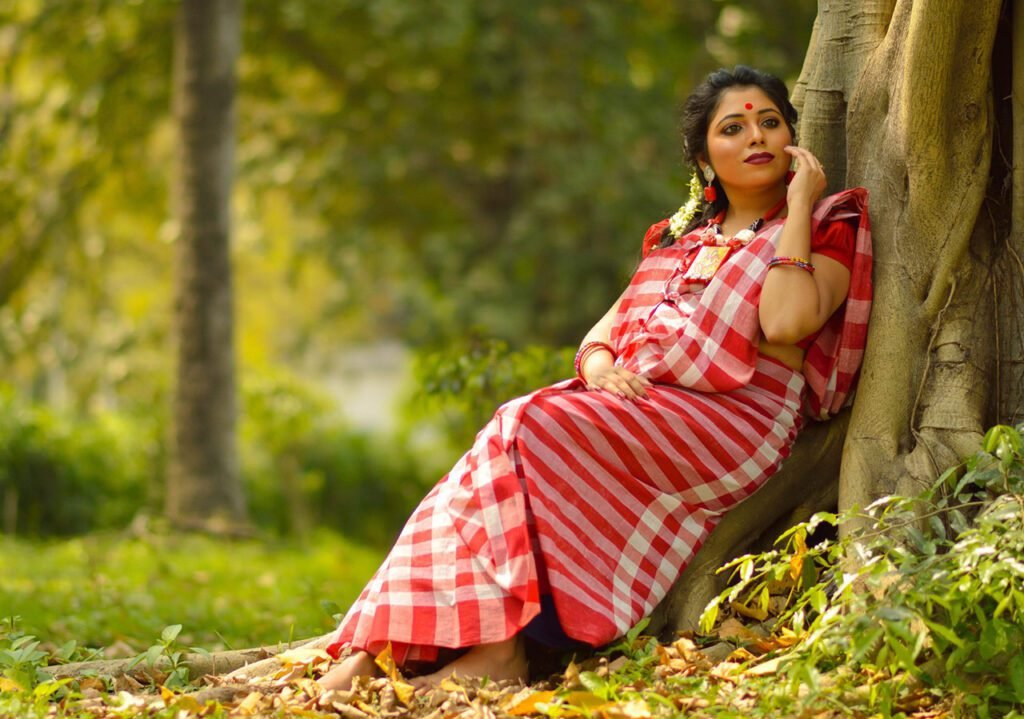

The Bengali culture has an air of elegance and aristocracy. The same spirit is reflected by the classic Bengali saree. Nothing says “Bengali” more than a woman sporting the cloth Taant or the elegance of silk Baluchari saree.
Different Styles of Bengali Saree Draping
The appeal of the Bengali saree is in the draping styles it can be worn. The ‘Atpoure’ fashion is popular in the holy festivals and the ‘Bengali Kalaai which has keys at the bottom in the “pallu’ is a an individual charm.
Significance and Cultural Contributions
A Bengali saree is a symbol of class and elegance and. The weaving looms of Bengal specifically Dhaniakhali, Shantipur, and Murshidabad have been contributing to the rich history of textiles of India for centuries.
Bengali Saree in Festivals and Celebrations
Any celebration, be it the splendor of ‘Durga puja or the warmth of ‘Poila Bishakh’ is echoed by the rustle of Bengali sarees. The air is brimming with the beauty of silk, cotton, and the timeless reminiscence of the “laal paar” (red border) that remains the same despite the turbulence of shifting tastes.
2. Assam: The Intricate Mekhela Chado
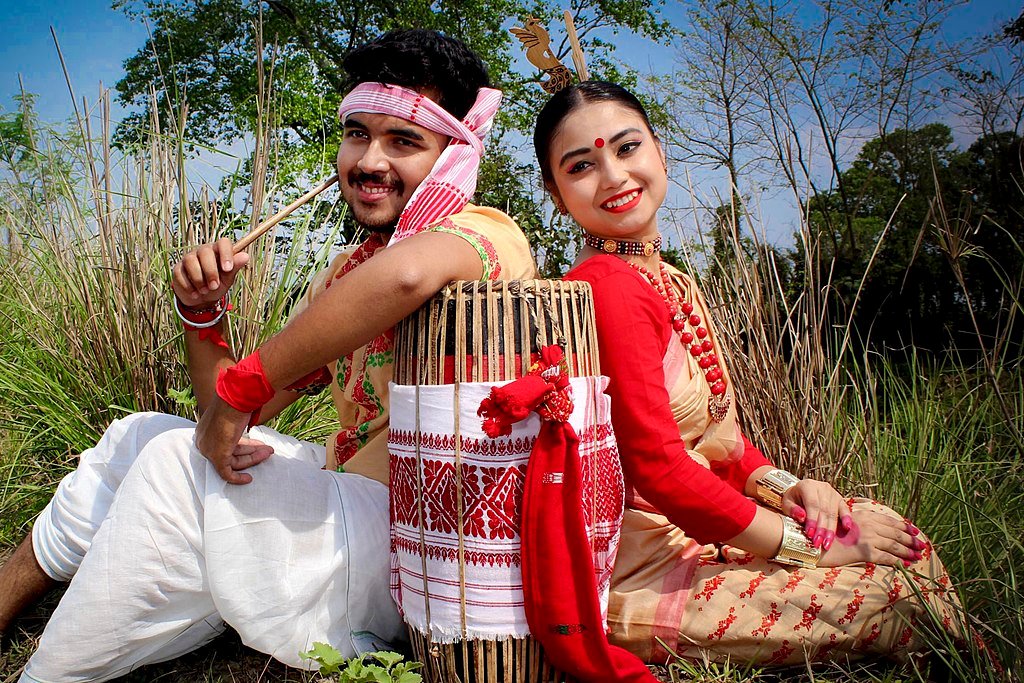

In the multitude of shades that decorate the scenery of Assam The stunning Mekhela Chador creates an irresistible impression, creating an Assamese woman a symbol of grace and class.
The Craftsmanship of the Mekhela Chador
Made on looms using designs drawn from the natural world, Mekhela Chador is a illustration of the rich Assam handloom tradition. The simple nature of the Muga cotton Muga and the extravagant look that is the Pat silk show the fineness and skill of the artisans from Assam.
Cultural Relevance and Symbolism of Mekhela Chador
It’s not simply a piece of clothing It’s a piece from Assamese life, and a relic of their history. It reflects the serene beauty of Assam and the tranquility of its people, and the modesty of its society.
Assamese Festivals and the Representation of Mekhela Chador
Mekhela Chador is an integral part of the entirety of Assamese celebrations. The dancers move to beat of ‘Bihu’. It and adds a touch of glamour to “Magh Bihu’, and adds elegance to family gatherings and instils the celebrations with a touch of elegance that is traditional.
South Indian States: An Ensemble of Splendid Diversity
South India, a melting pot of different cultures, traditions languages, histories, and languages is the home of one of the more intricate and beautifully created traditional clothes in India. Tamil Nadu and Kerala wearing the crown jewels of their attire with these Draped Sarees as well as Kasavu Mundu as well as Set Mundu.
1, Tamil Nadu: The Classic Draped Saree


In the region in Tamil Nadu, the classic style of saree drape is unique and speaks to the customs and traditions of the state.
The Styles and Varieties of Tamil Saree
It could be the coveted Kanjeevaram silk, or less frequently worn cotton sarees. Tamil Nadu offers a variety of sarees, all stunningly beautiful in its own distinctive style.
Cultural Importance and Significance of the Saree
The weave, design and the colour choices are very symbolic and have been tied to the traditions. The saree is considered to be an integral aspect of the woman’s identity within Tamil tradition.
The Role of Saree in Tamil Festivities and Rituals
From Pongal to marriage ceremonies the saree is a focal point throughout the Tamil Nadu’s celebrations and rituals. The best way to drape a saree is to wear it tucked into the waist, and is believed to honour the goddess of strength.
2. Kerala: The Pristine Kasavu Mundu and Set Mundu
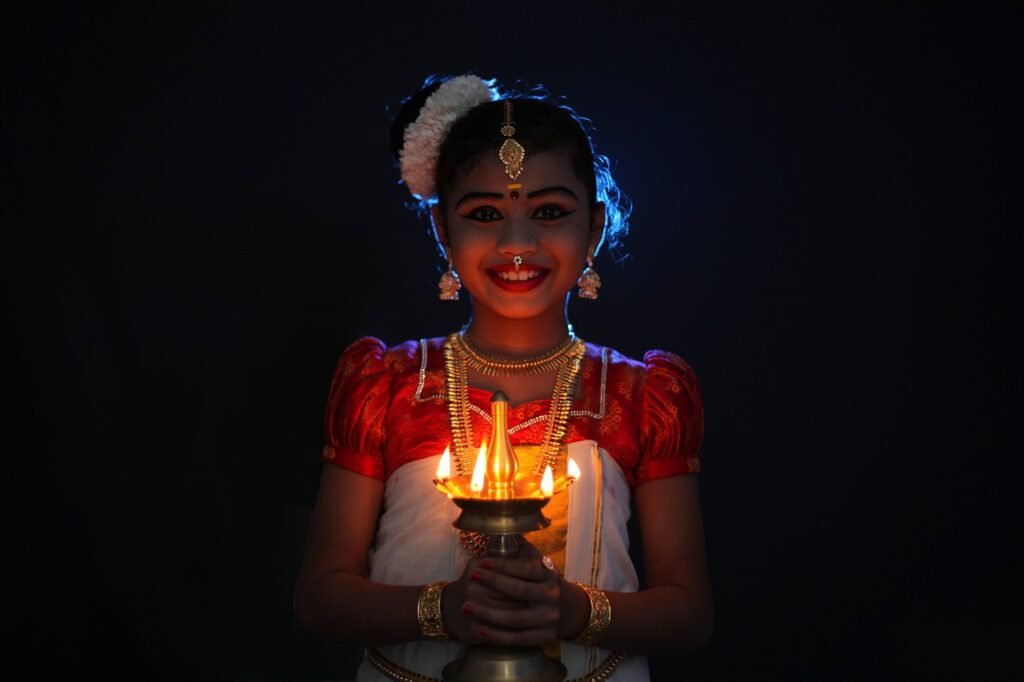

A traditional Kasavu Mundu as well as Set Mundu from Kerala are a symbol of simplicity and purity. The clothing is characterized by its unbleached cotton, with gold-coloured borders that adorn the garment.
Origin and Craftsmanship of Kasavu Mundu and Set Mundu
The attire is derived from Kerala’s martial art Kalaripayattu and similar clothing was worn to ease movement. The gold border is a symbol of the prosperity of Kerala and its cultural identity.
Significance and Symbolism of Kasavu Mundu and Set Mundu
Gold and white represent purity, a concept deeply and deeply rooted in Malayali practices and. During festive times the borders are typically decorated with elephants or peacocks, which are symbolic of the state’s varied species of flora and fauna.
Representation of The Dress in Kerala’s Culture and Festivities
Onam the state’s most significant celebration, or an Malayali wedding is not complete without the beautiful Kasavu Mundu as well as Set Mundu elegantly draped over the women and men alike.
West Indian States: Woven Stories in Threads and Colours
1. Maharashtra: The Historic Navaratri Saree
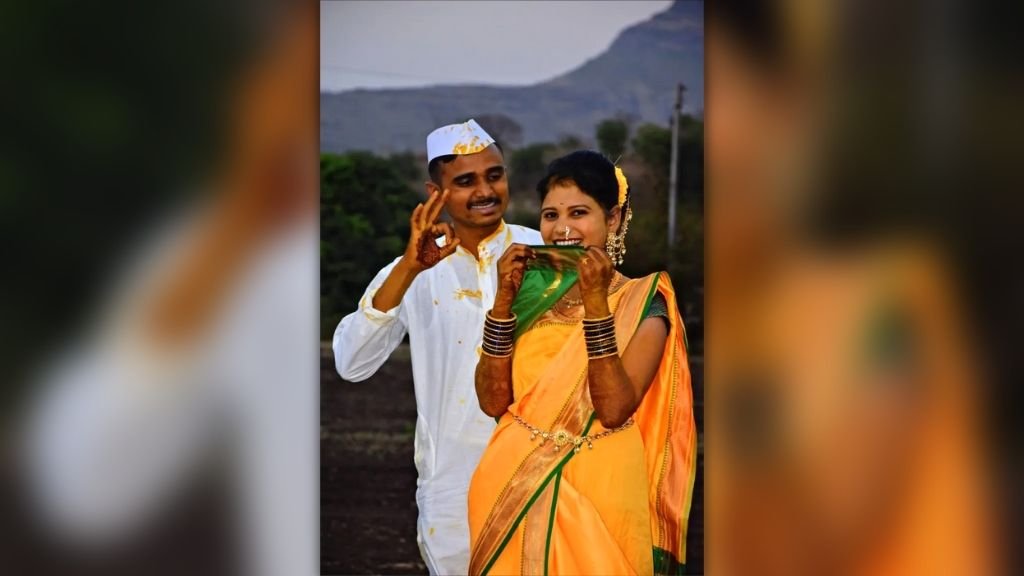

Famous for its distinctive drape and unique draping style, the Navaratri Sari of Maharashtra celebrates the diversity of India: A Travel Indian Traditional Dresses from Across States
The Distinct Draping Style of Navaratri
A trip to Maharashtra which is the heart of culture in West India, isn’t complete without recognizing the distinct style in the Navaratri Saree. “Navaratri,” which literally is a translation of ‘nine-yards’ is a gorgeously covered saree which has the ability to capture the hearts of locals as well as tourists alike.
The unique style of draping includes creating a tight trouser-like style beneath the waist. This naturally paved the way to feminist freedom in its period, giving women with the freedom to move around and work effortlessly.
Significance and Cultural Relevance of Navaratri
Sure the Navaratri is practical that is not often considered is its significance in the cultural context. It’s a symbol for Marathi culture, and embodies the values of modesty, bravery and strength.
Typically, they are woven with gold threads they tell an account of wealth in status, splendour, and style and are a popular choice for Maharashtrian brides often choosing Kasta sarees adorned with Navaratri drapes on their wedding day to preserve the old traditions.
Maharashtra Festivals and Navaratri Saree
Have you ever wondered what’s behind the sparkle of the Ganpati Festival in Maharashtra? It’s not a thing other than the Nauvari saree.
The women of the state at festivities, this traditional 9-yard saree is as lively and durable as the celebrations themselves. It is a symbol of their deeply-rooted tradition of culture that has been cultivated over decades.
As with the pretzel twist There’s a distinct way to wear theNavaratri saree. It is usually tied around the centre of the back and then is fashioned into an dhoti, which allows for more movement, particularly when dancing during the festive season.
The significance and essence in the Navaratri saree is not just in its beauty but in the symbolic meaning of Maratha power and the strength it represents.
2. Gujarat: The Flamboyant Chania Choli
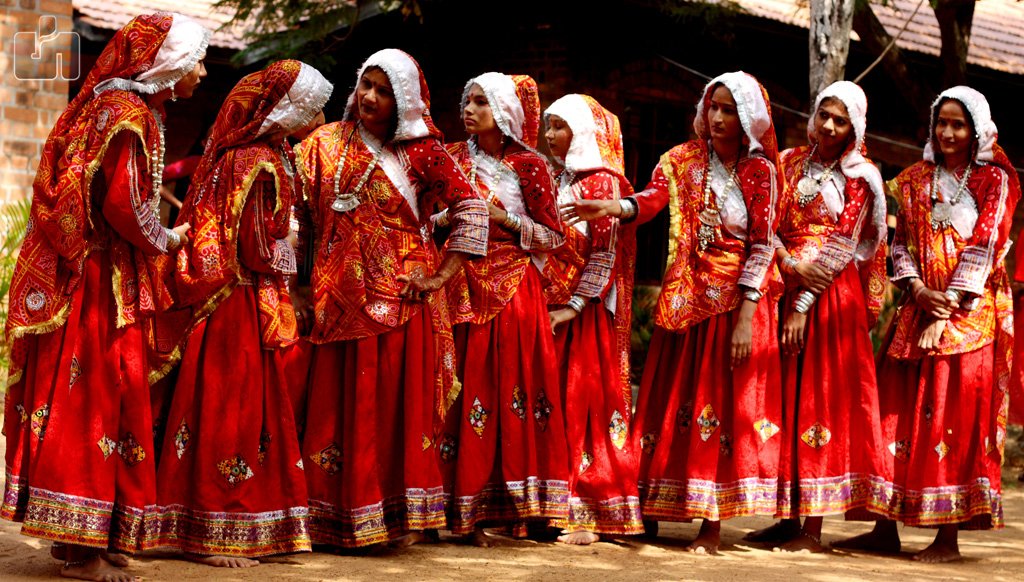

The lands of Gujarat are a vibrant one. of Gujarat The vibrant Chaniya Choli is a symbol of the vibrancy of culture. The three-piece outfit is worn by girls and women with a lot of excitement, the energy of every dancer being evident in the energetic swirls of these dresses in Garba, the legendary Garba dance.
You may have noticed that it is composed of ‘Chaniya’ that is the flared ankle-length skirt, ‘Choli’ which is a beautiful blouse and the ‘Dupatta’ which adds a stunning flow. I can assure you that every dance in these vibrant cholis is a brand new story of joy and laughter.
The Vibrant Colour Palette and Varieties of Chania Choli
Let’s start this fun journey across India’s states wearing the traditional dress from Gujarat and the Chaniya Choli. Lady and gentleman, do not make any mistake – this isn’t the typical blouse and skirt but it’s not! It’s a stunning outfit that is bursting with every shade you can imagine.
It is adorned with mirrors as well as sequins, beads, and, sometimes, filigree, it’s that unique detail that makes this outfit pop. A fascinating aspect of Chaniya Choli is that it varies dependent on the community. For example, the tribal Ghagra Choli is distinct from its urban counterparts, demonstrating the variety within the same state.
Tradition, Symbolism and Cultural Influence of Chania Choli
Think about for a moment an explosion of vibrant shades interspersed with delicate moulds of fabric, as women twirl in an ebullient manner with a dazzling grace and energy.
The stunning scene could be the beautiful Chaniya Choli, popularly worn in Western states of India mostly Gujarat as well as Rajasthan. It’s more than just a dress but also a representation of a the cultural identity of the region, symbolizing happiness, love and happiness.
With every Chaniya Choli telling its unique story using colourful fabrics, intricate embroidery and intricate mirrorwork, this traditional costume has a significant influence on the culture
It’s not just for wear in a fashion, but is also adorned with affection in celebrations like Navratri or Dandiya evenings, and is used as elegant dance clothes.
Festive Celebrations and Chaniya Choli
India the land of vibrant cultures, spice every festival by presenting a diverse array of ethnic costumes.
Like the beautiful skies on Diwali night, or the thump of dhol in Navratri, the traditional costumes are essential to jazz the celebrations. One of the ensembles that take the centre stage in Navratri can be described as that of the Chaniya Choli.
Traditionally worn by women from Gujarat in the month of Navratri, Chaniya Choli is a mystical combination of patterns, colours, and exquisite workmanship.
The colourful skirt (Chaniya) together to an odhani top (Choli) along with a flashy scarf (odhani) creates the trinity that, when embellished, transforms a regular gathering into an event of a different kind.
With the resonant sound that comes from Garba music, each swirl in the Chaniya Choli paints a mesmerizing image of India’s many traditions.
Central Indian States: Brimming with Traditional Elegance
Imagine traveling through the midst of India while taking in the vibrant colours of culture, tradition, and the past.
Central India, a melting pot of many cultural and religious traditions, provides an amazing view of elegance and tradition through its clothing. Oh, the sheer brilliance of geography and the way it reflects our lives!
1. Madhya Pradesh: The Regal Chanderi Saree
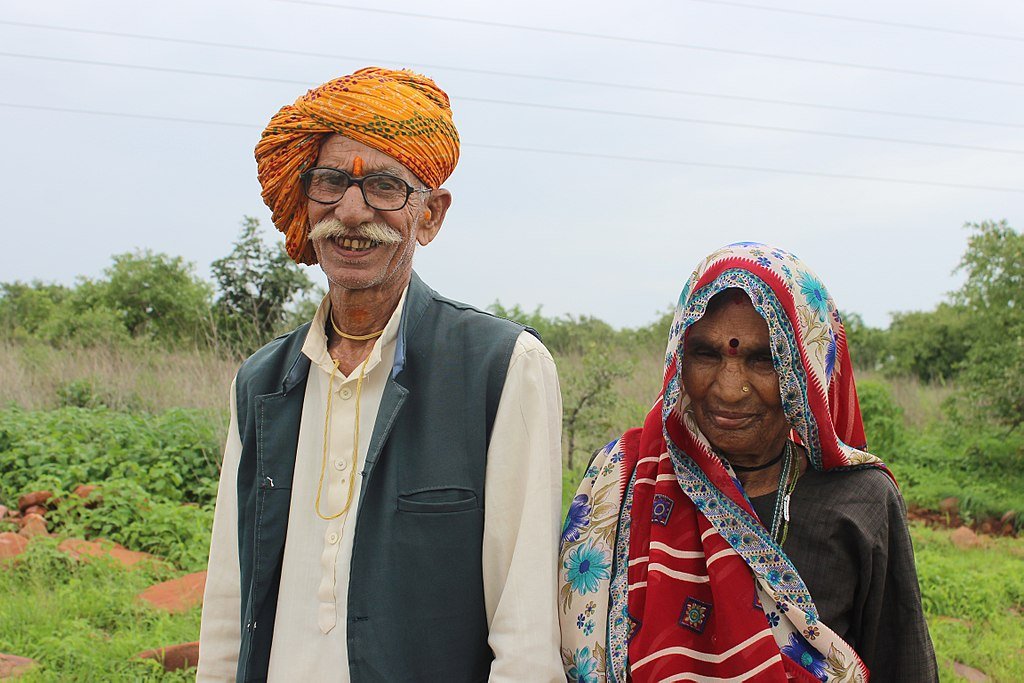

Where the wind screams the tempo of history Where the tradition and tradition are expressed through textiles located in the midst of India In the heart of India, namely Madhya Pradesh, lies the story of the royal Chanderi silk saree.
Similar to the state famous for its stunning beauty, historic landmarks, and diversity. royal Chanderi saree makes an unbeatable piece of this rich cultural canvas.
The Craft of Chanderi Weaving
Chanderi weaving dear isn’t an easy craft to master. It has been passed down over time and has an art of balancing accuracy and imagination.
Imagine a weaver absorbed in the tempo of dexterity weaving threads of silk and cotton to make the distinctive Chanderi cloth.
The effect is similar to watching a concert unfold. The patterns exquisite and finessed have a distinct language that is their own.
The striking peacock designs and floral designs, as well as geometrical and coin patterns all reflect the vast design of Chanderi’s history as well as the culture.
Importance and Traditional Use of Chanderi Saree
It is renowned for its unique sparkle, luxurious texture and captivating gossamer patterns The Chanderi saree isn’t just an item of clothing.
It’s a tradition and a work of art which is inextricably linked to the soul of India’s traditional culture. It is a quaint village located in Chanderi located in Madhya Pradesh, this saree is a reflection of the local tradition.
It’s made with precision which shows in its high-end quality and gorgeous motifs that are intricately weaved onto the sarees.
It is described as a emblem of elegance and grace Chanderi sarees are appreciated because of their light shiny transparency, glossy look and royal look, which is enhanced by their silver and gold Zari designs.
They are often worn for weddings or festivals as well as other important events, displaying the style and elegance of the wearer.
Significance of Chanderi Saree in Festivities
If it’s time to get into the festive look and dress up, what could be better than a stunning and elegant Chanderi Saree?
The elegance and grandeur that is a part of it make the holiday atmosphere more festive. It’s so elegantly wrapped around the wearer, you can’t be able to resist their gorgeous appeal.
When the jingling bells of Celebration echo in the background and dazzling baubles of Christmas sparkle in the background, the Chanderi Sari is draped in traditional elegance, creating an impression that is hard to forget.
The silver and gold designs are often a reflection of the symbols of the past are what set the festive theme, connecting the wearer to the roots of tradition and culture.
Recapitulating the Cultural Voyage through Indian Traditional Dresses
In the vast Indian landscape, traditional dresses are like a vibrant tapestry thread, weaving a story that echoes millennia of cultural heritage.
It’s like stepping into a costume drama where each state offers a unique character influenced by a distinctive set of cultural, geographical, and historical factors.
From the crisp white ‘mundu’ of Kerala to the colourful ‘lehenga choli’ of Rajasthan, and the elegant ‘mekhla chador’ of Assam to the royal ‘pattu pavadai’ of Tamil Nadu—every ensemble narrates an untold story.
Their intricate designs, patterns, and even the techniques used in their creation are all guided by the traditions passed down through generations, making the journey through Indian traditional dresses feel like embarking upon a grand cultural voyage.
But just like mirrors reflect our faces, these traditional dresses reflect the cultural ethos of the varied Indian regions.
And from this reflection emerges a rich narrative of diversity unified by communal identity and cultural harmony.
Importance of Preservation and Promotion of Traditional Attire
India takes immense pride in its cultural diversity and the preservation of its traditional attire is integral to this legacy. It’s like a well-thought, intricate tapestry woven with threads of history, geography, social norms, and spiritual beliefs.
Role of Traditional Dresses in Strengthening Cultural Unity in Diversity
Imagine this. You walk down lanes teeming with color, intricacy, and a million stories often intertwined with the threads of time.
Your eyes marvel at the richness and diversity fluttering by in the form of traditional dresses, each one a unique homage to its roots – this, my friend, is the vibrant tapestry of Indian traditional attire.
These garments tell tales of their native soil, often weaving unity in the midst of seemingly chaotic diversity, forming an integral part of India’s unique identity.
FAQ’s
Why are Traditional Dresses Important in Indian Culture?
You know, traditional dresses are much more than just clothes in Indian culture. They are laden with historical significance and cultural symbolism that narrates the story of the Indian civilization.
Indian traditional dress, be it the elegant saree or the dapper dhoti-kurta, echo the philosophy of unity amid diversity.
They go beyond mere clothing, telling tales of regional roots, societal hierarchy, and personal identities. Plus, they also add to the visual aesthetics because, let’s face it, they’re pretty darn attractive.
Isn’t it amazing that a single piece of cloth can embody such intricate dimensions? But, then again, that’s India for you.
How do Indian Traditional Dresses Differ from State to State?
When you look at the Indian map, you’ll realize that the variety is astounding. Trust me, folks, Indian wear, much like its food and languages, is influenced by geographical conditions, climatic factors, and local culture, varying from state to state. Think of it as a colourful runway showcasing India’s rich heritage.
In the beautiful valleys of Kashmir, you’ll see Pheran, a long woolen robe, keeping people warm, while in the hot sandy Rajasthan, Ghagra-Choli in vibrant hues is the preferred dress code. Travel further east to Assam, and the gorgeous Mekhela Chador will win your hearts. Pretty wild, right?
Why Do the Traditional Dresses Vary in Terms of Material, Design, and Utility?
Well, it’s rather like a plate of biryani: different ingredients, each individually significant, coming together to form something rich and intricate.
If you’ve ever wondered why there’s such a vast difference in traditional outfits across India, here’s the shakedown.
Perhaps there are few countries as vibrant and diverse as India, oozing a rich tapestry of traditions and cultures.
From the architecture to culinary delights and, notably, dress – the exquisite variety is something to behold.
In this article, we dive headfirst into the tantalizing world of traditional Indian attire against the backdrop of different Indian states.

Pingback: top 8 Best kurti with jeans
Pingback: 10 festive wear for women